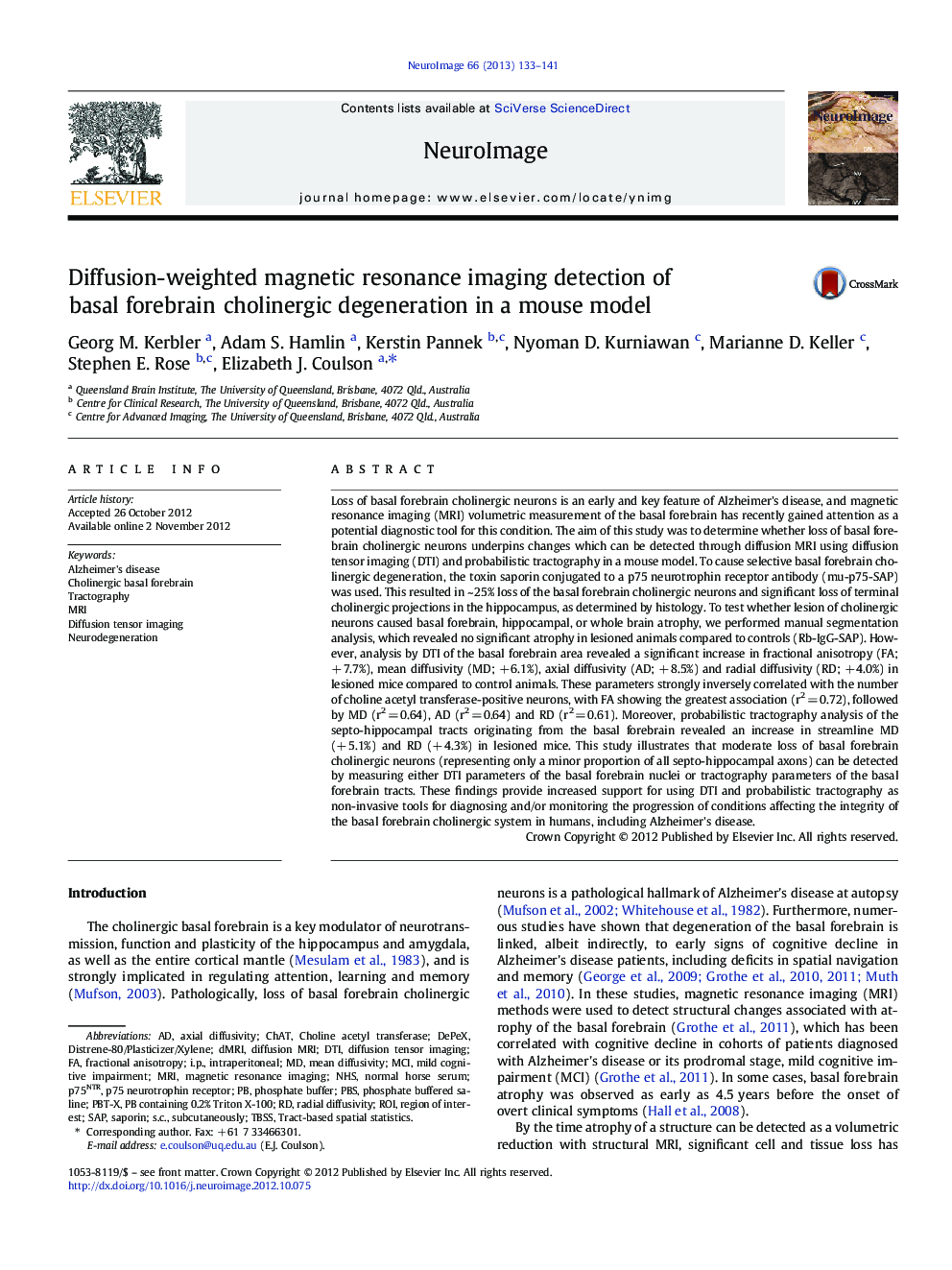| کد مقاله | کد نشریه | سال انتشار | مقاله انگلیسی | نسخه تمام متن |
|---|---|---|---|---|
| 6030559 | 1580938 | 2013 | 9 صفحه PDF | دانلود رایگان |
Loss of basal forebrain cholinergic neurons is an early and key feature of Alzheimer's disease, and magnetic resonance imaging (MRI) volumetric measurement of the basal forebrain has recently gained attention as a potential diagnostic tool for this condition. The aim of this study was to determine whether loss of basal forebrain cholinergic neurons underpins changes which can be detected through diffusion MRI using diffusion tensor imaging (DTI) and probabilistic tractography in a mouse model. To cause selective basal forebrain cholinergic degeneration, the toxin saporin conjugated to a p75 neurotrophin receptor antibody (mu-p75-SAP) was used. This resulted in ~Â 25% loss of the basal forebrain cholinergic neurons and significant loss of terminal cholinergic projections in the hippocampus, as determined by histology. To test whether lesion of cholinergic neurons caused basal forebrain, hippocampal, or whole brain atrophy, we performed manual segmentation analysis, which revealed no significant atrophy in lesioned animals compared to controls (Rb-IgG-SAP). However, analysis by DTI of the basal forebrain area revealed a significant increase in fractional anisotropy (FA; +Â 7.7%), mean diffusivity (MD; +Â 6.1%), axial diffusivity (AD; +Â 8.5%) and radial diffusivity (RD; +Â 4.0%) in lesioned mice compared to control animals. These parameters strongly inversely correlated with the number of choline acetyl transferase-positive neurons, with FA showing the greatest association (r2Â =Â 0.72), followed by MD (r2Â =Â 0.64), AD (r2Â =Â 0.64) and RD (r2Â =Â 0.61). Moreover, probabilistic tractography analysis of the septo-hippocampal tracts originating from the basal forebrain revealed an increase in streamline MD (+Â 5.1%) and RD (+Â 4.3%) in lesioned mice. This study illustrates that moderate loss of basal forebrain cholinergic neurons (representing only a minor proportion of all septo-hippocampal axons) can be detected by measuring either DTI parameters of the basal forebrain nuclei or tractography parameters of the basal forebrain tracts. These findings provide increased support for using DTI and probabilistic tractography as non-invasive tools for diagnosing and/or monitoring the progression of conditions affecting the integrity of the basal forebrain cholinergic system in humans, including Alzheimer's disease.
⺠Basal forebrain lesions were induced in mice using p75 antibody-conjugated saporin. ⺠Diffusion MRI revealed an increase in fractional anisotropy in the basal forebrain. ⺠Diffusion parameters inversely correlated with cholinergic neuron number. ⺠Tractography showed significant changes in diffusion parameters. ⺠Cholinergic degeneration in Alzheimer's disease may be detected using diffusion MRI.
Journal: NeuroImage - Volume 66, 1 February 2013, Pages 133-141
